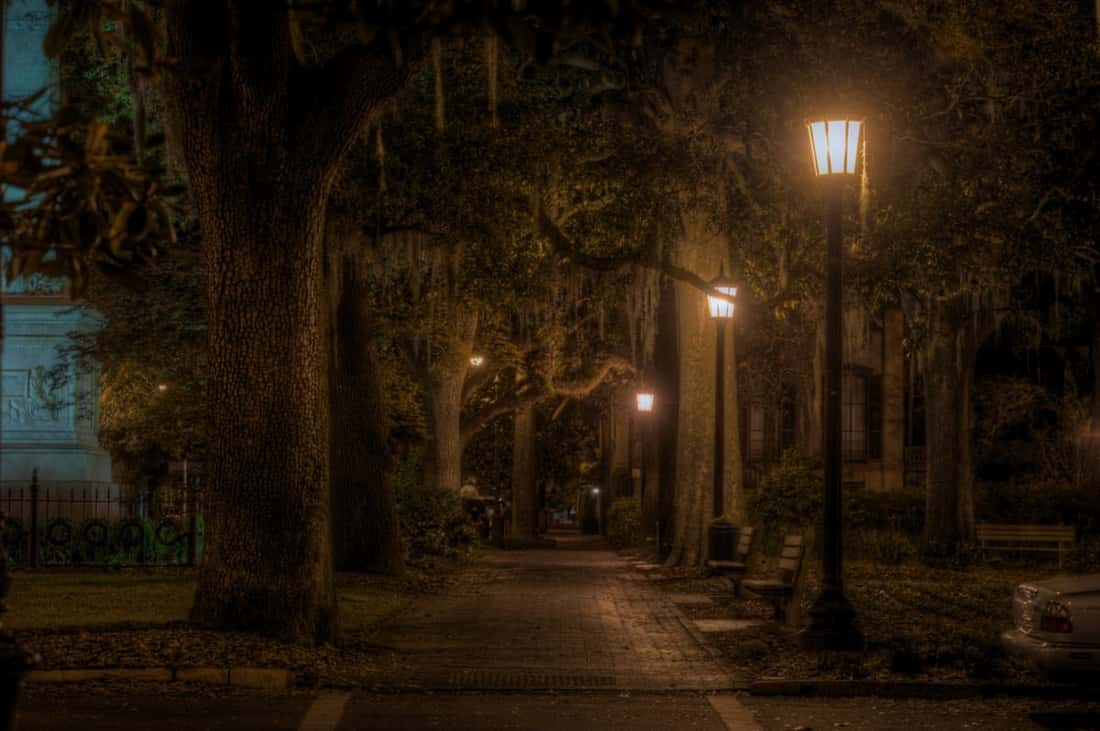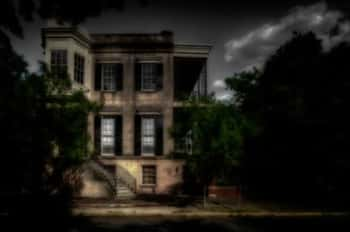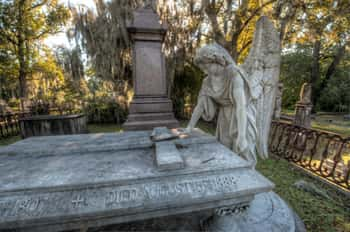
While giving ghost tours in Savannah, one of the most common questions we get asked is "Why is Savannah so haunted?". After all, Savannah has been named the most haunted city in America. There must be good reasons behind all of these ghosts, right? In the past we've talked about the Hidden Cemeteries and Burial Grounds of Savannah. While I do believe this contributes to hauntings in Savannah it is certainly not the only cause of the ghosts people see in Savannah. Today we will talk about another reason why Savannah is soo haunted, the battles and wars that were fought on the soil of Savannah. Do these battles and deaths have something to do with all of the ghosts and spirits in Savannah? Let us know what you think.
The second bloodiest battle of the American Revolutionary War was fought right here in Savannah. Not many people on our ghost tours realize this. After all, many of our tour guests associate the Revolutionary War with Boston, Lexington and other locations northward. On the west side of Savannah, the Siege of Savannah took place. In October of 1779, the French and Colonial soldiers tried to retake the city of Savannah. The attack was repulsed by the British. During the course of the fighting the French and Colonists took almost 1,000 casualties, the British had about 150. You can tour part of the preserved battlefield at the Spring Hill Redoubt. Even though Spring Hill is where the bulk of the attack took place there has been evidence uncovered as far away as Madison Square, that suggest that fighting took place there as well. Of course Madison Square is also thought to be the location of a mass grave of casualties from the battle of Savannah.
Ghosts and paranormal experiences are occasionally reported from people in Madison Square. Shadow people, visible orbs of light and more have all been seen there. Of course, the Sorrel Weed House is also on Madison Square, one of the famous haunted homes in Savannah.
Another bit of information that I have uncovered involves Calhoun Square. There is some evidence to suggest, without certainty, that the area of Calhoun Square was the location of skirmishing between the French and British during that October in 1779. The French troops were digging trenches in that area in order to get closer to the British lines. While this is not a positive event there seems to be a good deal of information and reports to suggest this is true.
It is well known that in 1864 General William Tecumseh Sherman made his way to Savannah on his famous March to the Sea. On the outskirts of Savannah, including Fort McAllister, there was a fair amount of fighting in the capture of Savannah by the Union Army. However, once capture was inevitable the influential men of Savannah decided to surrender the city instead of fight and have the city destroyed. Fighting in the city was almost no-existant. So, while there are numerous ghosts in Savannah that are associated with the Civil War none of them are a result of fighting within the city, as far as I know.
Ghosts seem to be a common occurrence on battlefields. One battlefield I have a lot of experience on, Gettysburg, comes to mind. Gettysburg is certainly right there with Savannah when it comes to ghosts and hauntings. This is a trend that cannot be ignored when trying to explain the number of ghosts, spirits and hauntings in Savannah. It might not be a coincidence that Madison Square is considered one of the more paranormally active places in town.
There might only be a few places in the United States that have seen more bloodshed during its named existence than Savannah, Georgia. One of the bloodiest moments in Savannah’s history was the Siege of Savannah (the Second battle of Savannah), and it was one of the most deadly battles to take place during the American Revolutionary War.
The siege occurred in the fall of the year 1779. It is believed that there were nearly a thousand patriot causalities on the field, soldiers who willingly gave their lives attempting to liberate Savannah from British occupation. The Americans were unsuccessful in what was considered to be the most important battle in Georgia during the Revolutionary War.
The carnage was so immense at the Siege of Savannah that the battle is perhaps one of the main reasons why Savannah is considered to be the most of haunted city in America. Upon visiting Savannah, people to this day have reportedly had encounters with these ghosts of the Revolutionary War and here are a few of those ghostly encounters below.

One spot in Savannah that is known for paranormal disturbances is the popular tourist stop, Madison Square. The square was named in honor of James Madison (the 4th President of the United States). One of the square’s most frequently spotted ghosts is the spirit of Sergeant William Jasper, whose spirit is possibly tied to Madison Square as it holds a statue of him. Jasper was killed during the Siege of Savannah.
Jasper was a sergeant for the 2nd South Carolina Regiment, who made a name for himself in the defense of Fort Moultrie during the Battle of Sullivan’s Island (The First Siege of Charleston), on June 28th, 1776. During the battle, a British warship shot away the patriot’s flagstaff. Jasper leapt into action and was able to recover the South Carolina flag. Jasper, while under heavy fire, proudly rose the flag over the fort, inspiring the men to rally against the British (in your face King George III).
For his bravery, Governor John Rutledge bestowed his sword to William Jasper. The victory and Jasper’s courageous act quickly became a symbol for the cause. A few years later, as the war continued on, Sergeant William Jasper and the 2nd South Carolina Regiment were called upon for the Siege of Savannah (September 16 – October 20, 1779), which was led by General Benjamin Lincoln. Unfortunately, this time around, things didn’t quite go the Americans’ way (well, played King George).
William Jasper was killed during the battle against the British forces. But, he was not forgotten in death—all across the country, there are counties and towns named after him. Though, for all the tributes to Jasper, only the monument in Madison Square can claim to have actually hosted the war hero. The spirit of William Jasper has been spotted countless times, roaming Madison square, most likely readying himself to fight the Redcoats once more.
Jasper has good reason to be on guard, as his spirit is not the only one to have been sighted on the grounds of Madison Square. Over the years, there has been a steady intake of reports, people claiming to have witnessed ghostly figures running toward them (with their tea and crumpets in a bunch), only for the shadowy presences to vanish right before their very eyes. Perhaps spooked themselves by the apparition of the patriot, William Jasper.

Monterey Square was laid in the year of 1847 to commemorate the Mexican-American War’s Battle of Monterey that occurred just a year earlier. But, while the Square is named in honor of the battle, in which General Zachary Taylor’s captured of The City of Monterey, in the heart of the square stands the Casimir Pulaski Monument.
The square was built near the site of the Siege of Savannah, a battle that claimed the life of Casimir Pulaski. While Pulaski’s name may not sound as Colonial American as William Jasper (who was actually born in Germany and later Americanized his name), Pulaski was indeed a true patriot.
From a young age, Pulaski believed in the right to freedom and became involved in the growing revolution in Poland against Russia. In fact, he was one of the founders of the Bar Confederation, whose association was goaled with the mission of defending the independence of the Polish–Lithuanian Commonwealth. Unsuccessful in this endeavor, Pulaski was forced to leave his homeland as an exile.
Influenced by Benjamin Franklin, Pulaski decided to immigrate to America. Pulaski believed in the possibilities of America, and the freedom of tyranny, and thus joined the cause. He quickly gained a reputation for his bravery, and was even noted for saving the life of General George Washington. Pulaski rose through the ranks to become a brigadier general and led his own legion of men.
During the Siege of Savannah, Pulaski was shot while rallying a charge as others retreated. His wound was so grave that most men would have died instantly, but Pulaski was able to hold on for two more days before succumbing to his injuries. In his death, Pulaski’s reputation only grew in the eyes of the American Patriots. And, while they lost this particular battle, Pulaski’s spirit lived on, helping to rally the Continental Army to victory from the British.
Pulaski’s burial site became a mystery, as no one knew of what exactly happened to his remains. Some said that he was buried at sea, while others insisted that he was buried just outside of Savannah. The truth would not be discovered until 1996, over two hundred years after his death. (There’s nothing quite like resurrecting the dead, don’t you think?) The Italian marble carved Pulaski Monument in Monterey Square was in desperate need of repair, with cracks and stains tarnishing its purpose. So, the city of Savannah began the process of having the monument renovated in the mid-1990s.
During the process of disassembling the monument for proper restoration, there was an incredible discovery. In the base of the monument, a small box was found and inside the box were remains. Speculation soon grew. Were these the remains of Pulaski? Well, DNA testing was conducted and while inconclusive, it was determined that the skeleton was consistent with the age of Pulaski and the inflicted injuries matched the historical records. In 2005, the remains were reinterned, this time with military honors.
Like many of the squares in Savannah, Monterey Square is known for its ghostly activity. Even before DNA evidence connected Pulaski to the square, there were legends of his ghost down in Monterey. Common reports of people talk of ghostly encounters with a man dressed in revolutionary era garb. Only, they almost always disregard him as a reenactor, based on his accent. But, upon, giving him a second glance, they are startled as he seemingly disappears into thin air.Monterey Square was laid in the year of 1847 to commemorate the Mexican-American War’s Battle of Monterey that occurred just a year earlier. But, while the Square is named in honor of the battle, in which General Zachary Taylor’s captured of The City of Monterey, in the heart of the square stands the Casimir Pulaski Monument.

A square in Savannah is just not complete without a monument of an American Revolutionary War hero, and at Johnson Square (the first established square in Savannah) the patriot who is honored is Nathanael Greene, a man who was only second in command to General George Washington. The square which is named after Robert Johnson (the colonial governor of South Carolina, not the legendary bluesman) is home to more than just a monument of Nathanael Greene.
You see, his body also lies under its grounds.
Greene died in the year 1786, and was buried in Savannah's Colonial Park Cemetery. Decades later, while under the Union's occupation during the Civil War, Union soldiers would desecrate the city's cemeteries, to the extent that many of Savannah's departed sons and daughters were lost forever. Greene and his son (George Washington Greene), who was buried alongside him, were not impervious to these acts of vandalism.
In the center of Johnson Square a consolatory monument was built to Greene in 1825, the cornerstone of which was laid by fellow hero of the Revolutionary War, Marquis de Lafayette. Once Greene's remains were rediscovered, and his son's were too, they were relocated to Johnson Square, arriving on November 14th of the year 1902.
Greene lived his life by a certain code, having resolved his Quaker faith was his righteous patriotism. However, it is believed that all of this unrest in the afterlife has left the spirit of Nathanael Greene bitter. Not just for his own disturbance, but also for his son's. As a result, Greene's ghost protects their burial site with a fearsomeness that he had only previously shown when facing the British. It is said that anyone who visits the Nathanael Greene Monuments in the shadows of the night may just be in for a freight when the wary soul of Greene emerges.
The tales of these Revolutionary War heroes are just a sample of the stories you'll hear when you go on an adventure with Ghost City Tours. You'll learn more than just the ghostly accounts, you'll learn their origins and the historical importance of these spirits. But, it is always best to stay on your toes, as you might just be the next person to have a paranormal encounter.

Savannah's oldest and most haunted Cemetery

Savannah's most infamous haunted house

A quiet, and haunted Cemetery in Savannah